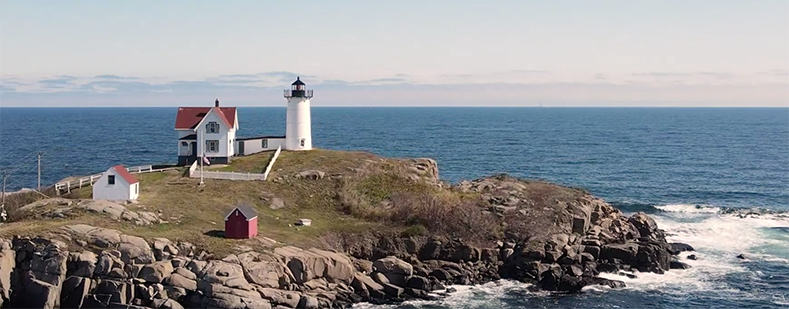Lighthouses are subject to Mother Nature’s harshest conditions: wind, rain, and constant exposure to salt water from the pounding waves of the ocean. It comes as no surprise that these structures and their various components require routine rehabilitation and restoration.
JB Leslie Co., Inc. has refurbished 22 lighthouses in New England, with the Nubble Lighthouse in Maine being one of the company’s most prestigious projects. “Logistics are a huge part of the challenge with lighthouse work – they are often remote and/or difficult to access. Nubble Lighthouse was no exception. We needed to remove corrosion and the old coatings from the cast iron gallery, tower and lantern, but getting equipment to the Nubble Lighthouse was a huge obstacle,” said Jim Leslie, owner of JB Leslie Co.
“Partnering with Sponge-Jet and using Sponge Media™ for abrasive blasting really made the difference on this job. Sometimes when you have limitations on equipment size and quantity, you have to reduce the quality and quantity of what you can do on the job. However, that was definitely not the case on the Nubble Lighthouse restoration,” added Leslie.

Preserving a Piece of History
The Cape Neddick Light Station, most commonly called the Nubble Lighthouse, sits on a rocky “nub” of an island approximately 100 yards off the coast of York Beach, Maine. The rocky coastline saw many shipwrecks prior to the construction of the Nubble Lighthouse in 1874. From that time until 1987, the structure was home to more than 30 lighthouse keepers and became a fixture in Maine’s coastal landscape. In 1987, the Nubble Lighthouse became the last lighthouse in North America to be automated. It is now listed on the National Register of Historic Places, and half a million visitors per year come to York’s Sohier Park to catch a glimpse of the picturesque structure.
Mobility and Access Solutions
When Leslie and his crew arrived on the scene at Nubble Lighthouse, they were tasked with many rehabilitation and restoration projects, but one of the most difficult was the removal of corrosion and failed coating on approximately 3,000ft² (280m²) of cast iron substrate.
Before the crew could get to work on cleaning and prepping the cast iron, they needed to solve the challenge of getting blasting equipment and media to and from the island. According to Leslie, there are only two ways to get equipment and supplies on and off the island: by raft or by a limited-weight zip-line system that uses cables and pulleys. Air lifting the equipment, supplies, and media was cost prohibitive, plus with the limited space on the island, in addition to the rock formations and precarious cliffs, this option even less feasible.
The crew looked at several options, including the use of hand-tools, dry ice blasting, baking soda blasting and use of walnut shells as the abrasive media. Ultimately, abrasive blasting with Sponge Media made the most sense from every standpoint. “We needed a process where the equipment had a small and versatile footprint on the island,” explained Leslie.
By using Sponge-Jet equipment and Silver 30 Sponge Media™, the crew was easily able to overcome all of the access and mobility challenges. “The compressor was situated on the mainland, with airlines suspended over the sea using a network of wires. The other equipment such as the recycler and an abrasive blasting pig were small enough that we could get them over to the island,” said Leslie. The crew consisted of 5-6 men per day, with one crewmate staying on the mainland to operate and monitor the compressor.
Recycled, Low Dust Media to the Rescue
In addition to a small equipment footprint, Sponge Media is recyclable, allowing for just 74 bags (3,000 lb [1,400kg]) of Silver 30 to be used. “Blasting with single use media would have increased the volume of media by three times. That would have decreased productivity and efficiency and increased trips on the zip-line system to and from the island,” said Leslie.
Blasting with Sponge Media produces little to no dust, so clean-up on the island was easy, and windscreens were the only containment method required. According to Leslie, members of his crew were able to work on other restoration and rehabilitation projects on the island, including repainting and reroofing the wooden house. Sponge Media blasting also caused no disturbance to the birds and other wildlife that call the island their home.
An Exciting Adventure
Over the years, Leslie and his team have become lighthouse restoration experts and are often called on to perform historic restorations and ongoing maintenance on these impressive and picturesque structures. “Restoring lighthouses has really opened my eyes to wonderful places that I never thought much about as a kid growing up in New England. And now we’ve found that Sponge Media is the best and most viable option for abrasive blasting and cleaning remote and hard to access lighthouses,” said Leslie.
To Learn More about Lighthouse Restorations, visit: https://blog.spongejet.com/lighthouse-restoration-101-why-sponge-media-is-a-great-choice








